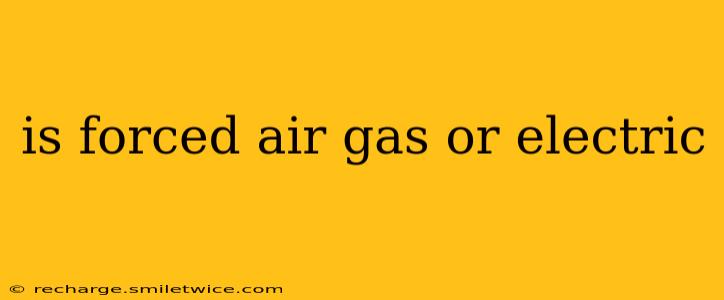Is Forced Air Gas or Electric? Understanding Your Heating System
The simple answer is: forced air heating systems can be either gas or electric. The "forced air" part refers to the method of distributing heat—a blower fan pushes heated air through ducts and vents throughout your home. The crucial difference lies in the source of the heat: natural gas or electricity. Let's delve into the specifics of each type.
What is forced air gas heating?
Forced air gas heating systems use a natural gas furnace as the heat source. The furnace burns natural gas to create heat, which then warms the air passing over a heat exchanger. This warm air is blown through the ductwork to heat your home. Gas furnaces are generally known for their efficiency and relatively lower operating costs compared to electric systems, especially in areas with low electricity prices.
What is forced air electric heating?
Forced air electric heating systems use electric resistance heating elements to warm the air. These elements, often located within the furnace or air handler, heat up and transfer their heat to the air, which is then circulated through your home's ductwork. While convenient and clean, electric furnaces typically have higher operating costs than gas furnaces, although their initial installation costs might be lower in some cases.
What are the pros and cons of each?
Let's break down the advantages and disadvantages to help you understand which system might be best for your home:
Forced Air Gas Heating:
Pros:
- Generally more efficient and cost-effective: Natural gas is often cheaper than electricity, leading to lower operating costs.
- Higher heat output: Gas furnaces typically produce more heat, ideal for larger homes or colder climates.
- Durable and long-lasting: With proper maintenance, gas furnaces can last for many years.
Cons:
- Requires a natural gas connection: This limits installation to areas with available natural gas lines.
- Potential for carbon monoxide leaks: Regular maintenance and CO detectors are essential for safety.
- Higher upfront installation costs (sometimes): Depending on your location and specific needs, the initial investment could be more substantial compared to electric.
Forced Air Electric Heating:
Pros:
- Clean and environmentally friendly: No combustion process means no greenhouse gas emissions directly from the furnace.
- Easy installation: Often simpler and quicker to install than gas furnaces, especially in areas without existing gas lines.
- Lower upfront costs (sometimes): Installation can be cheaper than gas furnaces in certain circumstances.
Cons:
- Higher operating costs: Electricity is generally more expensive than natural gas, leading to higher utility bills.
- Lower heat output compared to gas: May not be as effective in very cold climates or large homes.
- Can be less efficient in general: Depending on your location and electricity rates, the operating costs can quickly outweigh any upfront cost savings.
Which type is better for my home?
The "better" option depends on several factors:
- Your local energy costs: Compare the price of natural gas and electricity in your area.
- The size of your home: Larger homes might benefit from the higher heat output of a gas furnace.
- Climate: In colder climates, a gas furnace might be more efficient.
- Availability of natural gas: If you don't have access to a natural gas line, an electric furnace is your only option.
- Your budget: Consider both upfront installation costs and ongoing operating expenses.
Consulting with a qualified HVAC professional is crucial for determining the best forced air heating system for your specific needs and home. They can assess your home's size, insulation, and energy efficiency to recommend the most suitable and cost-effective option.
